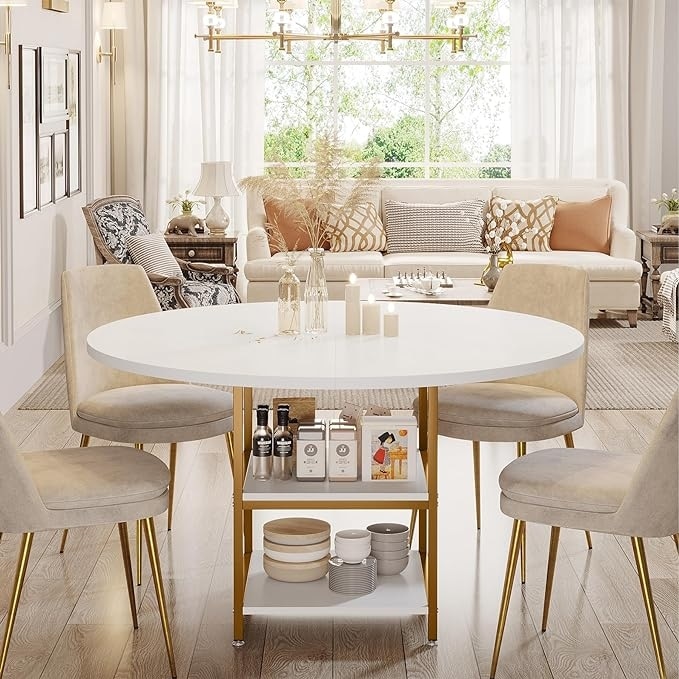The Best Materials for Durable and Elegant Dining Room Table Legs
The Best Materials for Durable and Elegant Dining Room Table Legs
Blog Article
From Typical to Modern: Find the Ideal Eating Area Table Legs for Your Style
While classic designs such as cabriole and transformed legs evoke a sense of timeless elegance, contemporary styles like hairpin and geometric alternatives provide a chance for striking visual rate of interest. As you consider these aspects, the inquiry remains: exactly how can you seamlessly incorporate these varied leg styles to develop a harmonious dining experience?
Understanding Table Leg Styles
The range of dining-room table leg styles can considerably influence both the visual appeals and functionality of the space. Each leg style adds special sensible attributes and aesthetic components, accommodating varied design choices and usage needs. Recognizing these designs is critical for selecting the right table that straightens with your total interior decoration vision.
For example, tapered legs provide a tidy, traditional look that can enhance a room's style, while pedestal bases provide security and take full advantage of legroom, making them excellent for smaller rooms. Barrette legs, a hallmark of mid-century modern layout, introduce an industrial panache, enabling for a ventilated, open feel. Trestle legs stimulate rustic beauty, giving robust assistance and a sense of eternity.
Wood legs can bring heat and texture, whereas metal alternatives commonly convey a streamlined, modern vibe. Inevitably, understanding table leg styles is important for producing a natural dining area that mirrors individual design while making sure functionality and comfort.
Standard Table Leg Options
When selecting dining-room table legs, standard alternatives often embody classic style and craftsmanship. These layouts mirror a rich heritage and a dedication to quality, making them excellent for those who appreciate traditional appearances.
One of the most renowned traditional leg styles is the cabriole leg, defined by its graceful rounded shape. This layout commonly features attractive carvings and is most frequently found in Queen Anne and Chippendale furniture. Another preferred alternative is the transformed leg, which boasts a collection of smooth, rounded shapes that provide a timeless appearance while keeping stability.
Furthermore, the straight leg, while basic, uses a unadorned and tough framework that can blend effortlessly with a selection of tabletop designs. For those drawn to ornate outlining, claw-and-ball feet legs stimulate a sense of grandeur and can serve as a stunning focal factor in any eating space.
Finally, stand bases, although not purely legs, provide a different conventional choice that enables ample legroom and can be beautifully sculpted. Each of these standard leg styles adds to the general setting of an eating room, marrying feature with aesthetic allure.

Modern Table Leg Styles
Modern table leg styles offer a diverse range of styles that highlight cutting-edge products and tidy lines. These designs commonly prioritize performance while working as striking prime focus within a dining room. Minimalist looks prevail, with legs crafted from products such as metal, glass, and crafted wood, which contribute to a airy and modern feeling.
One preferred design is the hairpin leg, defined by its slender, tapered framework that offers security without frustrating the tabletop (dining room table legs). This style is often located in mid-century modern furniture and can effortlessly enhance different table forms. One more trend is using geometric shapes, where legs may handle angular or unbalanced forms, including aesthetic interest and a touch of artistry

Mixing Designs for Distinct Spaces
Commonly, homeowners seek to create special dining areas that reflect their individual style by mixing different design components. This approach enables the consolidation of diverse aesthetics, leading to a harmonious yet unique atmosphere. For example, matching a rustic wooden table with streamlined, modern metal legs can develop a captivating contrast that raises the space's total charm.
In addition, incorporating vintage table legs with modern table tops can evoke a feeling of history while maintaining a modern-day perceptiveness. Such combinations not just display specific taste but additionally urge creativity, enabling property owners to curate a space that feels both individual and inviting.
Color plays an important function in this blending process; selecting table legs that match or comparison with the existing color plan can boost visual interest. Whitewashed legs can soften the daring of a dark table surface area, developing a balanced visual.
Tips for Picking the Right Legs
Choosing the right Visit Website table legs is essential for accomplishing both performance and visual charm in your eating space. Begin by taking into consideration the general style of your space. Conventional setups take advantage of legs that feature detailed makings or turned styles, while contemporary spaces might require smooth, minimal designs.
Following, analyze the elevation and stability of the legs. dining room table legs. Standard table range between 28 to 30 inches in height, so make certain the legs complement this measurement for convenience. Furthermore, robust products, such as hardwood or steel, can enhance security and longevity
Assess the leg shape as well-- alternatives consist of straight, tapered, or pedestal designs. Straight legs supply a classic look, while tapered legs can add a touch of style. Pedestal bases offer enough legroom and are optimal for smaller sized spaces.
Verdict
In summary, choosing the suitable dining area table legs calls for cautious factor to consider of both modern and traditional styles. By harmonizing leg style, elevation, and material with the overall design, a natural and welcoming environment can be achieved.
The selection of eating area table leg designs can significantly affect both the aesthetics and functionality of the room. Ultimately, understanding table leg designs is important for developing a natural dining area that mirrors personal style while making certain usefulness and convenience.One of the most iconic conventional leg designs is the cabriole leg, defined by its stylish bent shape. Straight legs offer a classic look, while conical legs can add a touch of elegance.In summary, selecting the ideal eating area table legs requires cautious consideration of both contemporary and standard styles.
Report this page